
Garden and Plate
The Molecular Biology of Nutrition








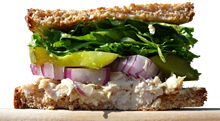


|
Photosynthesis refers to the carbohydrate-creating processes that take place in the chloroplasts of plant cells, and is divided into the light-dependent and light-independent processes. The light-dependent processes include the capture and storage of energy from the sun in the chemical bonds of ATP and NADPH molecules, and are collectively called Photosystems I and II. The light-independent processes create "pre-carbohydrate" molecules through carbon fixation, and are collectively referred to as The Calvin Cycle. The light-dependent processes take place on the surface of the Thylakoid, while the light-independent processes take place nearby in the Stroma. In a chloroplast, the Thylakoid is the equivalent of an organelle in the larger cell (outside the chloroplast), while the Stroma is the equivalent of the cytosol.
Both processes are interdependent: Photo-systems I and II create the ATP and NADPH molecules that power many of the reactions in the Calvin Cycle, and the Calvin Cycle returns energy-depleted ADP and NADP+ molecules back to the Photosystems to be "re-energized" back into ATP and NADPH, using energy from the sun.
While it's common practice to describe the Calvin Cycle as the set of reactions where the carbohydrates are created, this isn't entirely true. The end product of the Calvin Cycle is Glyceraldehyde 3-phosphate (GAP), which isn't a carbohydrate. GAP is converted into sucrose or starch in reactions that take place outside of the Calvin Cycle. I've summarized these steps in the "Post Calvin Cycle Reactions" section at the bottom of this page. The individual steps of the Calvin Cycle are described in detail below.
The Calvin Cycle Flow Chart - A visual representation of the steps involved in one complete turn of the Calvin Cycle. Three CO2 and three H2O molecules are added to create six glyceraldehyde 3-phosphate (GAP) molecules in steps 1-5 of the cycle. Steps 1-3 are known as the Carbon Fixation part of the Calvin Cycle, while steps 4-5 are the Reduction section. Five of the six GAP molecules are recycled in steps 6-15 to regenerate the original three RuBP molecules. This is called the Regeneration phase of the Calvin Cycle. The sixth GAP molecule is the product, and is used to create carbohydrates.
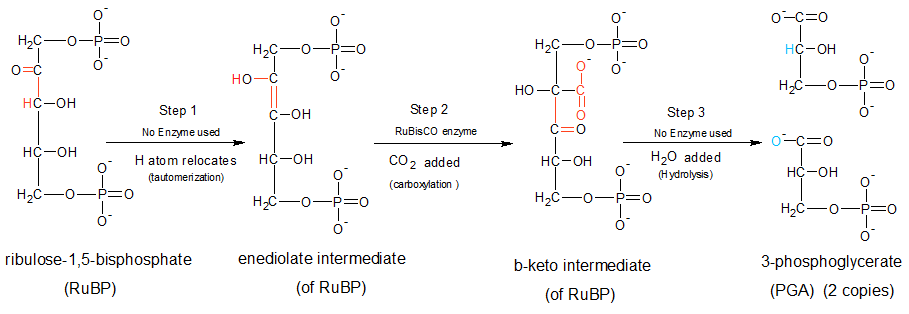
Steps 1 through 3: These images reveal the structural changes that molecules go through during the reactions that take place in steps one, two and three of the Calvin Cycle. These three steps are collectively known as Carbon Fixation. |
Step 1: The Calvin cycle starts with the Ribulose-1,5-Bisphosphate (RuBP) molecule. This molecule was created at the end of the last cycle, but must go through tautomerization to change it's shape into an enediolate form before it can be carboxylated in step two. In this case, tautomerization means that the hydrogen attached to the 3rd carbon moves to the Oxygen that's attached to the 2nd carbon. This causes the double bond that existed between the 2nd carbon and oxygen atoms to move to the link between the 2nd and 3rd carbons, causing the molecule to change shape. In an aqueous solution this happens automatically, and requires no enzyme activity or energy input.
All three of these reactions (tauterization, carboxylation and hydrolysis), are exergonic (meaning they release more energy than they consume), so ATP and NADPH were not used. An enzyme was used in only one of the three reactions (during carboxylation). The other two reactions were spontaneous. They occur automatically in water as hydrogen atoms make and break bonds due to normal thermal activity.
Step 2: Ribulose bisphosphate carboxylase (The RuBisCO enzyme) catalyzes a carboxylation reaction that combines a carbon-dioxide (CO2) molecule with the enediolate form of the RuBP molecule. This combination creates a 6-carbon beta-keto molecule out of the 5-carbon RuBP and 1-carbon (CO2) molecules. The CO2 molecule bonds to the 2nd carbon, which causes it to change it's double bond with the 3rd carbon to a single bond. This causes the 3rd carbon to change it's single bond with the oxygen atom to a double bond, which in turn causes the oxygen to release the hydrogen atom. These changes are marked in red in the above diagram.
Step 3: The beta-keto molecule is unstable, and instantly combines with a water molecule in a hydrolysis reaction that splits both molecules. The H2O molecule splits in two, creating a hydrogen atom and an OH (hydroxl) molecule. The b-keto molecule splits between the 2nd and 3rd carbon, where the double bond was recently converted into a single bond. The upper half of the molecule combines with the H atom, and the lower half combines with the OH molecule, which releases the H+ ion, but holds onto it's electron. The parts of the H2O molecule that were added are shown in blue in the above diagram. The product of this reaction is two molecules of 3-phosphoglycerate (PGA).
Summary: Carbon Fixation is a process in which one molecule of carbon-dioxide and one molecule of water are combined with one molecule of RuBP to get two molecules of 3-phosphoglycerate (PGA). This is one instance of a process that must happen three times, because the Calvin Cycle needs to create six PGA molecules before it can complete one full turn. That's why the flowchart of the entire Calvin Cycle (at the top of this page) has three carbon-dioxide molecules going in, with six molecules of PGA being produced, while the descriptions here and in the Steps 1 through 3 diagram have a single CO2 molecule going in, and only two PGA molecules coming out. One carbon atom is "fixed" (removed from the carbon-dioxide molecule) each time steps 1-3 of the Calvin Cycle are run. The extra GAP contains three carbon atoms, so three CO2 molecules must be consumed. In the next section we'll transform our six molecules of PGA into six molecules of GAP. The process shown in the Steps 4 and 5 diagram (below) will be repeated six times, once for each molecule.
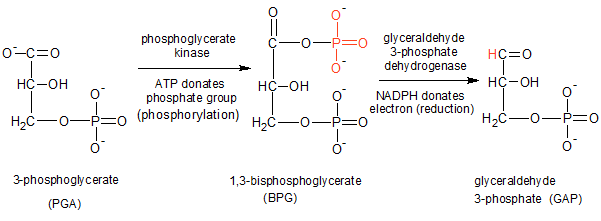
Steps 4 and 5: Each step is completed six times in order to create six molecules of GAP. Note: When Pi was added to PGA in step 4, it had three oxygens (PO3). When it was removed from BPG in Step 5, it had four oxygens (PO4). This is how the extra oxygen in carbon dioxide is removed from the Calvin Cycle, and how the carbon is "fixed". |
Step 4: The enzyme phosphoglycerate kinase phosphorylates the six molecules of 3-phospho-glycerate (PGA), using six molecules of ATP. This creates six molecules of 1,3-bisphospho-glycerate (BPG). Phosphorylation involves the transfer of a phosphate group (PO3, also known as inorganic phosphate or Pi) from ATP to PGA, creating BPG and ADP (ATP and ADP are not shown in the diagram). The added phosphate group is shown in red.
Step 5: Glyceraldehyde 3-Phosphate dehydro-genase reduces (donates electrons to) BPG using electrons from NADPH. This creates a molecule of Glyceraldehyde 3-phosphate (GAP or G3P). The reduction process removes a PO4 phosphate group from each molecule of BPG to create the GAP molecules. This was done six times, so six NADPH were converted into NADP+.
We've consumed three molecules each of RuBP, CO2 and H2O, plus six ATP and six NADPH molecules. We now have six Glyceraldehyde 3-phosphate (GAP) molecules. Five of these are needed to regenerate the original three RuBP molecules, which completes one turn of the Calvin Cycle.
The sixth GAP molecule is extra. It was built using the three carbon atoms brought into the cycle by the three CO2 molecules in Step two. This GAP molecule will be combined with another "extra" GAP molecule (from another complete turn of the Calvin Cycle), into a single molecule of fructose 6-phosphate (F6P). This takes place using the same reactions described in steps 6-8 of the Calvin Cycle.
F6P is the raw material that plants use to create carbohydrate. To see how F6P is used to create sucrose or starch, jump to the "Post Calvin Cycle" page. The remaining five GAP molecules will complete the Calvin Cycle by regenerating the original three RuBP molecules in steps six through fifteen.

Step 6 - Two GAP are converted to DHAP. |
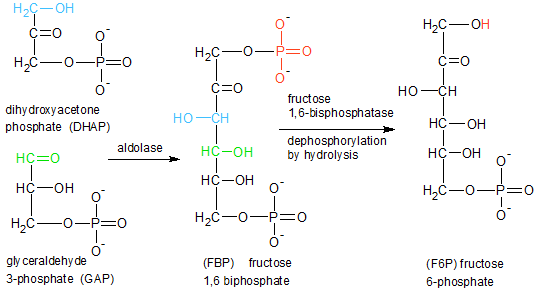
Step 7: Aldolase combines GAP and DHAP into FBP. Step 8: FBP is dephosphorylated into F6P. |
Step 6: The enzyme Triose phosphate isomerase changes the shape of two of the five GAP molecules into dihydroxyacetone phosphate (DHAP). Two hydrogen atoms are moved from the center CO group to the CO group on the end. This moves the double bond from the CO group on the end to the CO group in the center of the molecule. The number and types of atoms in both molecules are the same. No net energy is consumed in this reaction. The changes are in red in Figure 5.
Step 7: The enzyme aldolase combines one GAP and one DHAP into a 6-carbon fructose-1,6-bisphosphate (FBP) molecule. The FBP molecule has the same atomic content as the GAP and DHAP molecules combined (no atoms or charges added or lost in the conversion, and no net energy consumed). One of the two Hydrogen atoms bound to the blue DHAP carbon is moved to the green Oxygen atom on the GAP molecule. This frees up bonding spots on both the blue and green carbons, causing those two carbon atoms to form a covalent bond.
Step 8: The fructose-1,6-bisphosphatase enzyme uses hydrolysis to dephosphorylate FBP into a 6-carbon molecule of fructose 6-phosphate (F6P). Hydrolysis splits a molecule of water into H and OH groups. The H atom is added to the FBP molecule, which causes it to release the inorganic phosphate group (PO3-2). Hydrolysis consumes no net energy. This leaves us with one DHAP, one F6P and two GAP molecules.

Step 9: Transfer of a 2-carbon group (C2H3O2) from F6P to GAP creates E4P and Xu5P. |

Step 10: Aldolase combines the E4P and DHAP into SBP. Step 11: Sedoheptulose 1,7-bisphosphatase converts SBP into S7P. |
Step 9: Transketolase transfers a 2-carbon section (C2H3O2) from F6P to GAP. This converts F6P into a 4-carbon molecule of erythrose-4-phosphate (E4P), and GAP into a 5-carbon molecule of xylulose-5-phosphate (Xu5P). No net energy was consumed. We now have one E4P, one Xu5P, one DHAP, and one GAP molecule.

Step 13: Phosphopentose isomerase converts R5P into Ru5P. |
Step 10: The enzyme aldolase combines the E4P and DHAP molecules into a 7-carbon sedoheptulose 1,7-bisphosphate molecule. If this looks familiar, it's because aldolase did almost the same thing in step 7. The only difference this time is that we are using E4P instead of GAP. E4P has an extra HC-OH group in it. SBP contains all of the atoms that were in the E4P and DHAP molecules. No atoms were added or lost, and no net energy was consumed in the reaction. We now have one Xu5P, one SBP, and one GAP molecule.

Step 12: The enzyme transketolase transfers a two-carbon group (C2H3O2) from S7P to the last remaining GAP molecule. The transferred group is shown above in red. |

Step 14: Phosphopentose epimerase converts two Xu5P into two Ru5P. |
Step 11: Sedoheptulose 1,7-bisphospha-tase converts SBP into sedoheptulose 7-phosphate (S7P), using hydrolysis to de-phosphorylate it. A water molecule is used, and a Pi molecule is discarded.
Step 12: The enzyme transketolase transfers a 2-carbon section (C2H3O2) from the S7P molecule to the last remaining GAP molecule. This is the same 2-carbon molecule that was transferred in step 9, but it's coming from a different starting molecule. This turns S7P into a ribose-5-phosphate (R5P) molecule, and GAP into a Xu5P molecule. We now have one R5P and two Xu5P molecules.

Step 15: Phosphoribulokinase uses three ATP to phosphorylate three Ru5P into three RuBP molecules. These are the same three RuBP molecules that we started with in Step 1, so the Calvin Cycle is complete. |
Step 13: The enzyme phosphopentose isomerase converts ribose 5-phosphate (R5P) into Ribulose-5-phosphate (Ru5P). We now have one Ru5P and two Xu5P molecules.
Step 14: The enzyme phosphopentose epimerase converts each of the two Xu5P molecules into Ru5P. The shape of the molecule is being changed, but no atoms were added or removed. We now have three molecules of Ru5P.
Step 15: Phosphoribulokinase converts three ATP molecules into ADP in order to phosphorylate three Ru5P molecules into three ribulose-1,5-bisphosphate (RuBP) molecules. This brings us back to where we started in step 1, which completes the Calvin cycle.
What we gained by running through the Calvin Cycle was the creation of a single extra GAP molecule (a Triose Phosphate that's also called Glyceraldehyde 3-phosphate or G3P). It was created by running through steps 1-5 of the Calvin Cycle three times. Steps 6-15 are then run once (using the other five GAP molecules), in order to regenerate the three RuBP molecules needed to start the cycle again.
One GAP molecule isn't enough to create carbohydrate, so the Calvin Cycle must be repeated in order to generate another GAP. Once two extra GAP molecules are created, they are combined into fructose 6-phosphate (F6P) using steps 6-8 of the Calvin Cycle. F6P is the raw material used by plants in the creation of sucrose and starch. We examine those processes at the Post Calvin Cycle page.
Let's take a closer look at what the creation of this GAP molecule cost us, and what we got for our trouble. Three carbon-dioxide, three water, nine ATP, and six NADPH molecules were consumed in the creation of this single GAP molecule. The carbon-dioxide and water were provided by the environment, while the ATP and NADPH molecules were created in the "light-dependent" stages of photosynthesis called Photosystems I and II, using energy from the sun.
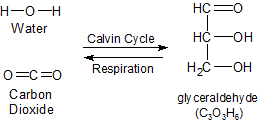
The Calvin Cycle converts three water and three carbon dioxide molecules into one molecule of glyceraldehyde. The six left over oxygen atoms are released into the atmosphere where they are available for use in respiration. |
One molecule of glyceraldehyde 3-phosphate (GAP) exited the Calvin Cycle at the end of step five. It's a molecule of glyceraldehyde with a phosphate group attached. If you remove the phosphate group, the glyceraldehyde has a chemical composition of C3O3H6. This is the same chemical content found in three molecules of water and three molecules of carbon dioxide, with six extra oxygen atoms. The CO2 and H2O inserted in steps two and three of the Calvin Cycle were transformed into one molecule of glyceraldehyde. What did this accomplish?
Notice that in both CO2 and H2O, all of the bonds are either C-O or H-O. There are no C-C or C-H bonds. In the glyceraldehyde molecule, there are two C-C bonds and four C-H bonds. Some of the highly electronegative C-O and H-O bonds were replaced with relatively low electronegative C-C and C-H bonds during the creation of glyceraldehyde. This means that some of the electrons were moved "uphill" into higher energy orbitals in steps 1-5 of the Calvin Cycle. That's where the energy from the nine ATP and six NADPH molecules went. This process is called carbon fixation because it converts some of the O-C bonds into C-C and C-H bonds. These bonds can then supply energy during respiration by converting carbohydrate back into water and carbon dioxide. That's what the Calvin Cycle is all about.